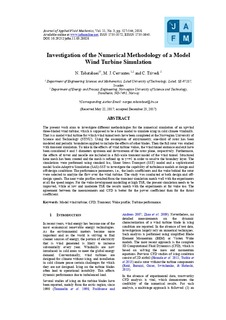| dc.contributor.author | Tabatabaei, Narges | |
| dc.contributor.author | Cervantes, Michel | |
| dc.contributor.author | Trivedi, Chirag | |
| dc.date.accessioned | 2019-08-30T09:06:11Z | |
| dc.date.available | 2019-08-30T09:06:11Z | |
| dc.date.created | 2018-05-12T07:14:32Z | |
| dc.date.issued | 2018 | |
| dc.identifier.citation | Journal of Applied Fluid Mechanics. 2018, 11 (3), 527-544. | nb_NO |
| dc.identifier.issn | 1735-3572 | |
| dc.identifier.uri | http://hdl.handle.net/11250/2611789 | |
| dc.description.abstract | The present work aims to investigate different methodologies for the numerical simulation of an upwind three-bladed wind turbine; which is supposed to be a base model to simulate icing in cold climate windmills. That is a model wind turbine for which wind tunnel tests have been completed at the Norwegian University of Science and Technology (NTNU). Using the assumption of axisymmetry, one-third of rotor has been modeled and periodic boundaries applied to include the effects of other blades. Then the full rotor was studied with transient simulation. To take in the effects of wind turbine wakes, the wind tunnel entrance and exit have been considered 4 and 5 diameters upstream and downstream of the rotor plane, respectively. Furthermore, the effects of tower and nacelle are included in a full-scale transient model of the wind tunnel. Structured hexa mesh has been created and the mesh is refined up to y+=1 in order to resolve the boundary layer. The simulations were performed using standard k-e, Shear Stress Transport (SST) model and a sophisticated model Scale-Adaptive Simulation (SAS)-SST to investigate the capability of turbulence models at design and off-design conditions The performance parameters, i.e., the loads coefficients and the wake behind the rotor were selected to analyze the flow over the wind turbine. The study was conducted at both design and offdesign speeds. The near wake profiles resulted from the transient simulation match well with the experiments at all the speed ranges. For the wake development modelling at high TSR, the present simulation needs to be improved, while at low and moderate TSR the results match with the experiments at far wake too. The agreement between the measurements and CFD is better for the power coefficient than for the thrust coefficient | nb_NO |
| dc.language.iso | eng | nb_NO |
| dc.publisher | Isfahan University of Technology | nb_NO |
| dc.rights | Attribution-NonCommercial-NoDerivatives 4.0 Internasjonal | * |
| dc.rights.uri | http://creativecommons.org/licenses/by-nc-nd/4.0/deed.no | * |
| dc.title | Investigation of the Numerical Methodology of a Model Wind Turbine Simulation | nb_NO |
| dc.type | Journal article | nb_NO |
| dc.type | Peer reviewed | nb_NO |
| dc.description.version | publishedVersion | nb_NO |
| dc.source.pagenumber | 527-544 | nb_NO |
| dc.source.volume | 11 | nb_NO |
| dc.source.journal | Journal of Applied Fluid Mechanics | nb_NO |
| dc.source.issue | 3 | nb_NO |
| dc.identifier.doi | 10.18869/acadpub.jafm.73.246.28028 | |
| dc.identifier.cristin | 1584664 | |
| dc.description.localcode | This work is licensed under a Creative Commons Attribution-NonCommercial-NoDerivatives 4.0 International License. | nb_NO |
| cristin.unitcode | 194,64,25,0 | |
| cristin.unitname | Institutt for energi- og prosessteknikk | |
| cristin.ispublished | true | |
| cristin.fulltext | original | |
| cristin.qualitycode | 1 | |

